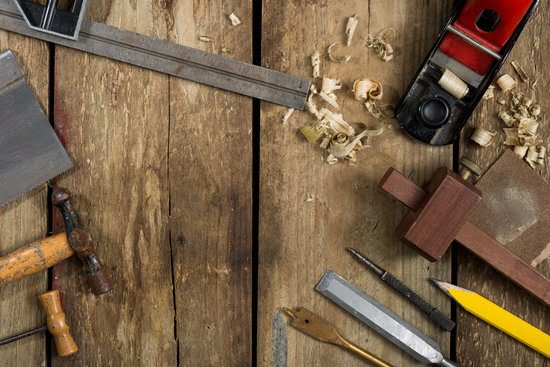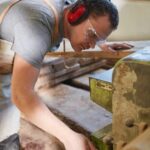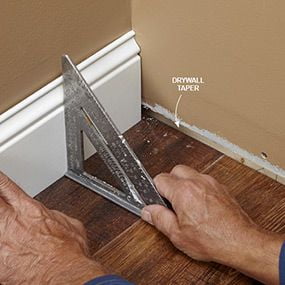Woodworking is a fulfilling and rewarding hobby or profession, but it also comes with its own set of safety considerations. One crucial aspect to consider when stepping into the workshop is what to wear for woodworking. Proper attire not only ensures your safety but also contributes to your overall comfort and efficiency while working with wood.
When it comes to dressing for woodworking, safety should always be the top priority. Wearing the right clothing and gear can protect you from potential hazards in the workshop, such as flying debris, sharp tools, and harmful chemicals. From head to toe, every item of clothing plays a critical role in keeping you safe and preventing accidents.
In addition to safety, the material of your woodworking attire also matters. Choosing the right fabric can make a significant difference in terms of comfort and durability. Breathable fabrics that allow for ease of movement are ideal for woodworking activities that require precision and focus. Selecting the appropriate material can enhance not only your safety but also your overall productivity in the workshop.
Essential Clothing Items for Woodworking
When it comes to woodworking, wearing the right attire is essential for both safety and comfort. From protecting yourself against sharp tools and flying wood chips to ensuring you can move freely and comfortably while working on your projects, selecting the proper clothing items is crucial. Here are some essential clothing items that every woodworker should have from head to toe:
- Headgear: A durable and well-fitting cap or hat is important to protect your head from dust, debris, and even accidental bumps. Consider a baseball cap or a snug beanie depending on the season.
- Upper Body: Opt for long-sleeved shirts made of breathable fabrics like cotton or moisture-wicking materials to keep you cool and dry. Avoid loose or baggy tops that could get caught in machinery.
- Lower Body: Choose sturdy work pants that provide ample protection for your legs. Denim or canvas pants are popular choices due to their durability. Avoid shorts or loose-fitting pants that could potentially catch on tools.
In addition to these basic clothing pieces, wearing appropriate footwear is also crucial when woodworking. Closed-toe shoes with non-slip soles are recommended to protect your feet from heavy objects, sharp tools, and potential spills in the workshop. Steel-toed boots offer an extra layer of protection for your toes in case something heavy falls on them.
Remember that what you wear for woodworking should prioritize safety without sacrificing comfort. By investing in quality safety gear such as aprons, hearing protection, knee pads, and steel-mesh gloves as needed, you can ensure that you stay protected while enjoying your time in the workshop. The right attire can make all the difference in preventing accidents and injuries while working with wood.
Choosing the Right Material
When it comes to woodworking, choosing the right material for your attire is crucial for ensuring both comfort and safety in the workshop. The type of fabric you wear can greatly impact your experience while working with wood, so it’s important to pay attention to this aspect of your clothing choices. Whether you’re a seasoned pro or just starting out, here are some considerations on why fabric matters when deciding what to wear for woodworking.
Breathability and Durability
One key factor to consider when selecting the fabric for your woodworking attire is its breathability and durability. Working with wood can be a dusty and sweaty task, so opting for fabrics that are breathable allows for better airflow and ventilation. Additionally, durable fabrics can withstand potential wear and tear from handling wood materials and using various tools in the workshop.
Moisture-Wicking Properties
Another important consideration when choosing the right fabric for woodworking attire is its moisture-wicking properties. Woodworking can be a physically demanding activity that can make you work up a sweat. Fabrics that have moisture-wicking capabilities help draw sweat away from your skin, keeping you dry and comfortable throughout your woodworking projects.
Protection Against Hazards
Lastly, selecting fabrics that offer protection against potential hazards in the workshop is essential when deciding what to wear for woodworking. Look for fabrics that can resist cuts, scratches, or splinters from wood materials to ensure your safety while working with power tools or sharp objects. This extra layer of protection offered by the right fabric choice can make a significant difference in preventing injuries during woodworking tasks.
Protective Gear
When it comes to woodworking, protective gear is essential to ensure your safety and well-being in the workshop. Gloves, goggles, and respirators are key pieces of equipment that every woodworker should have on hand to prevent injuries and exposure to harmful substances. Here are some tips on what to wear for woodworking in terms of protective gear:
- Gloves: Invest in a good pair of gloves that fit well and provide adequate protection for your hands. Leather gloves are recommended as they offer durability and can protect against splinters, cuts, and abrasions.
- Goggles: Safety goggles are crucial for protecting your eyes from flying debris, sawdust, and other hazards in the workshop. Make sure the goggles fit securely and provide full coverage for maximum protection.
- Respirators: Woodworking involves various airborne particles and chemicals that can be harmful if inhaled. A quality respirator with appropriate filters is essential to protect your lungs from dust, fumes, and other respiratory irritants.
By wearing the proper protective gear like gloves, goggles, and respirators, you can minimize the risks associated with woodworking and focus on your craft without compromising your health.
Remember that safety should always come first when choosing what to wear for woodworking. Make sure to inspect your protective gear regularly for any signs of wear or damage, and replace them as needed to ensure continued effectiveness in safeguarding yourself while working with wood.
In the next section about comfort vs. safety, we will explore how you can strike a balance between being protected and feeling comfortable while working on your woodworking projects. Stay tuned for more tips on dressing for success in woodworking.
Comfort vs Safety
Comfort Is Key
When it comes to woodworking, finding the balance between safety and comfort is essential. While protective gear like gloves, goggles, and respirators are crucial for your safety, it’s also important to consider your comfort while working in the workshop. Choosing clothing items that allow you to move freely and comfortably can make a significant difference in your productivity and overall experience.
The Right Fit
When selecting what to wear for woodworking, opt for clothing that fits well without being too loose or too tight. Loose clothing can get caught in machinery, leading to accidents, while overly tight garments can restrict movement and hinder your work. Look for pieces that are specifically designed for woodworking or DIY projects, as they offer the right balance of fit, protection, and comfort.
Breathable Fabrics and Moisture-Wicking Materials
Consider the type of material used in the clothing you choose to wear for woodworking. Breathable fabrics like cotton or moisture-wicking materials can help keep you cool and dry throughout your workday. Avoid synthetic materials that may cause overheating or discomfort. Additionally, layered clothing made of breathable fabrics allows you to adjust your attire according to temperature fluctuations in the workshop so you can focus on your project without distractions.
Layering Up
When it comes to woodworking, temperature fluctuations in the workshop can be a common challenge. To adapt to these changes, one of the key considerations is how you dress. Layering up is essential for maintaining a comfortable and safe working environment while allowing you to easily adjust to shifting temperatures throughout the day.
Start with a moisture-wicking base layer to keep sweat away from your body and help regulate your temperature. This can be especially beneficial during warmer periods or when you’re engaged in physically demanding tasks.
On top of that, consider adding an insulating layer like a fleece jacket or vest that can trap heat without adding bulk. Finally, finish off your ensemble with a breathable outer layer that can shield you from cold drafts or splinters while still allowing for ventilation.
It’s important to choose clothing items that are not only protective but also offer versatility in adapting to changing conditions. By layering up smartly, you can ensure that you stay comfortable and focused on your woodworking projects regardless of the workshop’s temperature swings.
| Temperature Fluctuations | Layering Strategy |
|---|---|
| Warm Periods | Moisture-wicking base layer |
| Cooler Temperatures | Fleece jacket or vest for insulation |
| Cold Drafts | Breathable outer layer for protection |
Accessorizing for Efficiency
When it comes to woodworking, having the right tools and equipment is essential for a successful and efficient project. However, equally important is having the proper attire to keep you safe, comfortable, and organized while working in the workshop. One key aspect of accessorizing for efficiency in woodworking is investing in tool belts and pockets to keep your essential tools close at hand.
Tool belts are a practical accessory for woodworkers as they provide easy access to commonly used tools such as hammers, screwdrivers, tape measures, and more. By having your tools within reach at all times, you can streamline your workflow and reduce time wasted searching for misplaced tools. Additionally, tool belts help you stay organized and prevent clutter in your workspace, allowing you to focus on the task at hand without distractions.
Another useful accessory for woodworking efficiency is clothing with numerous pockets. Cargo pants or shorts with multiple pockets are ideal for storing small tools, measuring tapes, pencils, screws, nails, and other essentials while working on a project.
This eliminates the need to carry around a separate tool belt and provides convenient storage options for various items that may be required during woodworking tasks. Ultimately, by accessorizing with tool belts and clothing with ample pockets, you can enhance your productivity and overall experience in the workshop.
Maintaining and Cleaning Your Woodworking Attire
One of the essential aspects of woodworking attire that often gets overlooked is maintenance and cleanliness. Proper care of your woodworking clothes not only ensures their longevity but also helps in maintaining their effectiveness in providing protection and comfort while you work on your projects. To ensure that your clothing continues to serve you well, here are some tips and tricks for maintaining and cleaning your woodworking attire.
Regularly inspect your woodworking clothes for any signs of wear and tear, such as fraying, holes, or weakened areas. Make sure to mend these issues promptly to prevent further damage to your attire. Additionally, washing your woodworking clothes after each use is crucial to remove any sawdust, debris, or chemicals that may have accumulated during your work sessions. Follow the manufacturer’s instructions when washing your attire to avoid shrinking or damaging the fabric.
When it comes to cleaning your woodworking attire, consider using a gentle detergent and cold water to preserve the integrity of the fabric. Avoid using harsh chemicals or bleach as they can weaken the fibers of the material over time.
If possible, air dry your clothing instead of using a dryer as excessive heat can also damage the fabric. Proper storage of your woodworking clothes is equally important – keep them in a clean, dry place away from direct sunlight or moisture to prevent mildew or mold growth.
By taking the time to maintain and clean your woodworking attire properly, you not only extend their lifespan but also ensure that they continue to provide you with the necessary protection and comfort while working on your projects. Investing in good-quality clothing for woodworking is essential, but caring for them correctly will help maximize their usefulness in the workshop for years to come.
Conclusion
In conclusion, dressing appropriately for woodworking is not just about looking the part but ensuring safety and efficiency in the workshop. From head to toe, wearing the right attire can make a significant difference in your woodworking experience. Starting with essential items like durable pants, long-sleeved shirts, and sturdy footwear is crucial in protecting yourself from splinters, sharp objects, and potential injuries.
When considering what to wear for woodworking, it is important to pay attention to fabric choices that are both comfortable and protective. Opting for materials like denim or canvas can provide durability and resilience against wear and tear in a workshop environment. Additionally, investing in protective gear such as gloves, goggles, and respirators is essential to safeguard your hands, eyes, and respiratory system from dust, debris, and harmful fumes.
Finding the balance between comfort and safety is key when dressing for woodworking projects. While layering up allows versatility in handling temperature fluctuations in the workshop, accessorizing with tool belts and pockets can enhance efficiency by keeping tools within reach. Remember that maintaining and regularly cleaning your woodworking attire is vital for prolonging its lifespan and effectiveness. By following these guidelines, you can ensure a safe, comfortable, and productive woodworking experience every time you step into the workshop.
Frequently Asked Questions
How Do You Dress in a Woodshop?
When working in a woodshop, it is essential to wear suitable attire that prioritizes safety and comfort. This includes clothing made of durable materials that can protect your skin from wood splinters and sharp tools. It’s best to avoid loose-fitting clothing, as it can get caught in machinery.
What Do Woodworkers Wear?
Woodworkers typically wear clothing that is practical for the job at hand. This often includes jeans or work pants that can withstand wear and tear, along with sturdy boots or closed-toe shoes for protection. Many woodworkers also opt for work shirts or flannels that provide some level of insulation and breathability.
What Is the Dress Code for Carpentry?
The dress code for carpentry usually involves wearing clothing that allows for ease of movement and provides adequate protection from potential hazards in the workshop. This may include long-sleeved shirts to protect the arms, as well as gloves to prevent splinters and cuts.
Additionally, wearing appropriate footwear with good grip is crucial to prevent slips and falls while working with heavy materials.

Hi everyone! I’m a woodworker and blogger, and this is my woodworking blog. In my blog, I share tips and tricks for woodworkers of all skill levels, as well as project ideas that you can try yourself.





